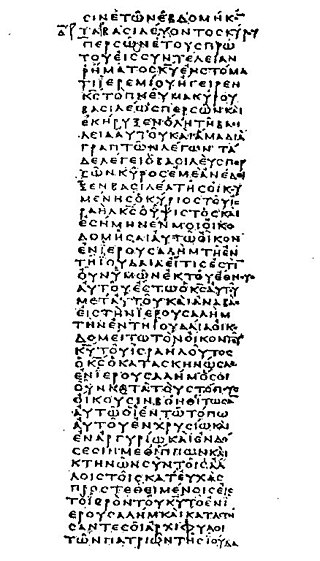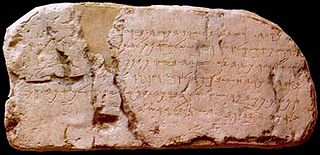Aramaic is a Northwest Semitic language that originated in the ancient region of Syria and quickly spread to Mesopotamia, the southern Levant, southeastern Anatolia, Eastern Arabia and the Sinai Peninsula, where it has been continually written and spoken in different varieties for over three thousand years.

The Bible is a collection of religious texts and scriptures that are held to be sacred in Christianity, and partly in Judaism, Samaritanism, Islam, the Baháʼí Faith, and other Abrahamic religions. The Bible is an anthology originally written in Hebrew, Aramaic, and Koine Greek. The texts include instructions, stories, poetry, prophecies, and other genres. The collection of materials accepted as part of the Bible by a particular religious tradition or community is called a biblical canon. Believers in the Bible generally consider it to be a product of divine inspiration, but the way they understand what that means and interpret the text varies.
The Hebrew alphabet, known variously by scholars as the Ktav Ashuri, Jewish script, square script and block script, is an abjad script used in the writing of the Hebrew language and other Jewish languages, most notably Yiddish, Ladino, Judeo-Arabic, and Judeo-Persian. In modern Hebrew, vowels are increasingly introduced. It is also used informally in Israel to write Levantine Arabic, especially among Druze. It is an offshoot of the Imperial Aramaic alphabet, which flourished during the Achaemenid Empire and which itself derives from the Phoenician alphabet.

Hebrew is a Northwest Semitic language within the Afroasiatic language family. A regional dialect of the Canaanite languages, it was natively spoken by the Israelites and remained in regular use as a first language until after 200 CE and as the liturgical language of Judaism and Samaritanism. The language was revived as a spoken language in the 19th century, and is the only successful large-scale example of linguistic revival. It is the only Canaanite language, as well as one of only two Northwest Semitic languages, with the other being Aramaic, still spoken today.

The Septuagint, sometimes referred to as the Greek Old Testament or The Translation of the Seventy, and abbreviated as LXX, is the earliest extant Greek translation of the Hebrew Bible from the original Biblical Hebrew. The full Greek title derives from the story recorded in the Letter of Aristeas to Philocrates that "the laws of the Jews" were translated into the Greek language at the request of Ptolemy II Philadelphus by seventy-two Hebrew translators—six from each of the Twelve Tribes of Israel.

The Masoretic Text is the authoritative Hebrew and Aramaic text of the 24 books of the Hebrew Bible (Tanakh) in Rabbinic Judaism. The Masoretic Text defines the Jewish canon and its precise letter-text, with its vocalization and accentuation known as the mas'sora. Referring to the Masoretic Text, masorah specifically means the diacritic markings of the text of the Jewish scriptures and the concise marginal notes in manuscripts of the Tanakh which note textual details, usually about the precise spelling of words. It was primarily copied, edited, and distributed by a group of Jews known as the Masoretes between the 7th and 10th centuries of the Common Era (CE). The oldest known complete copy, the Leningrad Codex, dates to 1009 CE and is recognized as the most complete source of biblical books in the Ben Asher tradition. It has served as the base text for critical editions such as Biblia Hebraica Stuttgartensia and Adi.

Louis Cappel was a French Protestant churchman and scholar. A Huguenot, he was born at St Elier, near Sedan. He studied theology at the Academy of Sedan and the Academy of Saumur, and Arabic at the University of Oxford, where he spent two years. At the age of twenty-eight, he accepted the chair of Hebrew at Saumur and, twenty years later, was appointed professor of theology. Amongst his fellow lecturers were Moses Amyraut and Josué de la Place.

The Bible has been translated into many languages from the biblical languages of Hebrew, Aramaic, and Greek. As of November 2024 the whole Bible has been translated into 756 languages, the New Testament has been translated into an additional 1,726 languages, and smaller portions of the Bible have been translated into 1,274 other languages according to Wycliffe Global Alliance. Thus, at least some portions of the Bible have been translated into 3,756 languages.

Exegesis is a critical explanation or interpretation of a text. The term is traditionally applied to the interpretation of Biblical works. In modern usage, exegesis can involve critical interpretations of virtually any text, including not just religious texts but also philosophy, literature, or virtually any other genre of writing. The phrase Biblical exegesis can be used to distinguish studies of the Bible from other critical textual explanations.
Biblical studies is the academic application of a set of diverse disciplines to the study of the Bible, with Bible referring to the books of the canonical Hebrew Bible in mainstream Jewish usage and the Christian Bible including the canonical Old Testament and New Testament, respectively. For its theory and methods, the field draws on disciplines ranging from ancient history, historical criticism, philology, theology, textual criticism, literary criticism, historical backgrounds, mythology, and comparative religion.

Biblical Hebrew, also called Classical Hebrew, is an archaic form of the Hebrew language, a language in the Canaanitic branch of the Semitic languages spoken by the Israelites in the area known as the Land of Israel, roughly west of the Jordan River and east of the Mediterranean Sea. The term ʿiḇrîṯ "Hebrew" was not used for the language in the Hebrew Bible, which was referred to as שְֹפַת כְּנַעַןśəp̄aṯ kənaʿan "language of Canaan" or יְהוּדִיתYəhûḏîṯ, "Judean", but it was used in Koine Greek and Mishnaic Hebrew texts.

Tiberian Hebrew is the canonical pronunciation of the Hebrew Bible (Tanakh) committed to writing by Masoretic scholars living in the Jewish community of Tiberias in ancient Galilee c. 750–950 CE under the Abbasid Caliphate. They wrote in the form of Tiberian vocalization, which employed diacritics added to the Hebrew letters: vowel signs and consonant diacritics (nequdot) and the so-called accents. These together with the marginal notes masora magna and masora parva make up the Tiberian apparatus.
The Jewish Neo-Aramaic dialect of Urmia, a dialect of Northeastern Neo-Aramaic, was originally spoken by Jews in Urmia and surrounding areas of Iranian Azerbaijan from Salmas to Solduz and into what is now Yüksekova, Hakkâri and Başkale, Van Province in eastern Turkey. Most speakers now live in Israel.

The Hebrew language uses the Hebrew alphabet with optional vowel diacritics. The romanization of Hebrew is the use of the Latin alphabet to transliterate Hebrew words.

Jehovah is a Latinization of the Hebrew יְהֹוָהYəhōwā, one vocalization of the Tetragrammaton יהוה (YHWH), the proper name of the God of Israel in the Hebrew Bible / Old Testament. The Tetragrammaton is considered one of the seven names of God in Judaism and a form of God's name in Christianity.
Biblical languages are any of the languages employed in the original writings of the Bible. Some debate exists as to which language is the original language of a particular passage, and about whether a term has been properly translated from an ancient language into modern editions of the Bible. Scholars generally recognize three languages as original biblical languages: Hebrew, Aramaic, and Koine Greek.

The Jerusalem School Hypothesis is one of many possible solutions to the synoptic problem, that the Gospel of Luke and the Gospel of Matthew both relied on older texts which are now lost. It was developed by Robert Lindsey, from the Jerusalem School of Synoptic Research.
Biblical Hebrew orthography refers to the various systems which have been used to write the Biblical Hebrew language. Biblical Hebrew has been written in a number of different writing systems over time, and in those systems its spelling and punctuation have also undergone changes.
Ancient Hebrew writings are texts written in Biblical Hebrew using the Paleo-Hebrew alphabet before the destruction of the Second Temple in 70 CE.
Benjamin D. Sommer is an American biblical scholar and Jewish theologian. He is a Professor of Bible at The Jewish Theological Seminary of America and a Senior Fellow at the Shalom Hartman Institute. He is a former director of the Crown Family Center for Jewish Studies at Northwestern University.











